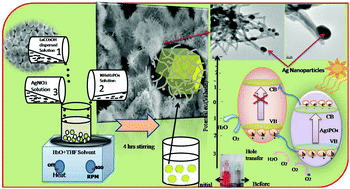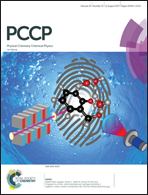Growth study of hierarchical Ag3PO4/LaCO3OH heterostructures and their efficient photocatalytic activity for RhB degradation†
Abstract
We have demonstrated the synthesis of Ag3PO4/LaCO3OH (APO/LCO) heterostructured photocatalysts by an in situ wet chemical method. From pre-screening evaluations of photocatalysts with APO/(x wt% LCO) composites with mass ratios of x = 5, 10, 15, 20, 25 and 30 wt%, we found that the APO/LCO (20 wt%) exhibited a superior photocatalytic activity for organic pollutant remediation. Therefore, an optimised photocatalyst APO/LCO (20 wt%) is selected for the present study and we investigate the effect of a mixed solvent system (H2O:THF) on the morphology, which has a direct effect on the photocatalytic performance. Interestingly, a profound effect on the morphological features of APO/LCO20 heterostructures was observed with variation in the ratio of the solvent system. From the FESEM study it is observed that the LCO spherical nanoparticles are transformed into nanorods with the variation of THF into the solvent system. Moreover, these LCO nanorods make intimate contact with the APO microstructures which is helpful for the improvement of the photocatalytic activity. The photocatalytic activities of the APO/LCO composites with different solvent ratios were evaluated by the degradation of rhodamine B (RhB) under visible light irradiation. Excellent photocatalytic activity was observed for the APO/LCO-2 (H2O : THF = 60 : 40) sample. This might be due to uniform covering of the APO microstructures by fine LCO rod-like structures offering intimate contact between the APO and LCO and providing proper channels for the degradation reactions. Furthermore, with an increasing THF volume ratio in the reaction system there was an increase of the dimensions of the LCO rod-like structures and also a loose compactness of their uniform intimate contact between the APO/LCO heterostructures. All in all, the enhanced photocatalytic activity of the APO/LCO heterostructures is attributed to the collective co-catalytic effect of LCO, by providing accelerated charge separation through the heterojunction interface, and THF, by helping to tune the unique morphological features which eventually facilitate the photocatalysis process.



 Please wait while we load your content...
Please wait while we load your content...